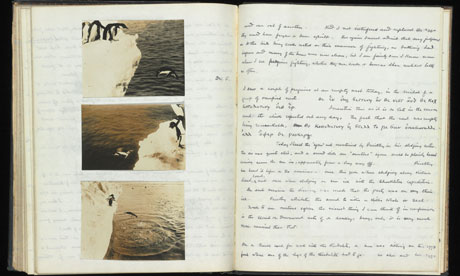Landmark polar research about the Adélie penguin's sex life by Captain Scott's expedition, deemed too shocking for the public 100 years ago, is unearthed at the Natural History Museum
http://www.guardian.co.uk/world/2012/jun/09/sex-depravity-penguins-scott-antarctic
Robin McKie, science editor
guardian.co.uk, Saturday 9 June 2012 11.31 BST

Dr George Murray Levick's observations of Adélie penguins were recorded in his notebook. Photograph: R Kossow/NHM
It was the sight of a young male Adélie penguin attempting to have sex with a dead female that particularly unnerved George Murray Levick, a scientist with the 1910-13 Scott Antarctic Expedition. No such observation had ever been recorded before, as far as he knew, and Levick, a typical Edwardian Englishman, was horrified. Blizzards and freezing cold were one thing. Penguin perversion was another.
Worse was to come, however. Levick spent the Antarctic summer of 1911-12 observing the colony of Adélies at Cape Adare, making him the only scientist to this day to have studied an entire breeding cycle there. During that time, he witnessed males having sex with other males and also with dead females, including several that had died the previous year. He also saw them sexually coerce females and chicks and occasionally kill them.
Levick blamed this "astonishing depravity" on "hooligan males" and wrote down his observations in Greek so that only an educated gentleman would understand the horrors he had witnessed. Back in Britain he produced a paper (in English), titled Natural History of the Adélie Penguin. However, the section about the animal's sexual proclivities was deemed to be so shocking it was removed to preserve decency. Levick then used this material as the basis for a separate short paper, Sexual Habits of the Adélie Penguin, which was privately circulated among a handful of experts.
Adelie penguins with chick Two Adélie penguins with a chick. Steve Bloom/Alamy
In fact, Levick's observations turned out to be well ahead of their time. Scientists had to wait another 50 years before the remarkable sexual antics of the Adélie were revealed. By this time his pamphlet and its detailed records of Adélie shenanigans had been lost to science.
But now a copy of Sexual Habits of the Adélie Penguin has been unearthed, thanks to sleuthing by Douglas Russell, curator of birds at the Natural History Museum, who discovered a copy among records of the work of Scott's expeditions and has had it published in the journal Polar Record, with an accompanying analysis of Levick's work.
"The pamphlet, declined for publication with the official Scott expedition reports, commented on the frequency of sexual activity, auto-erotic behaviour, and seemingly aberrant behaviour of young unpaired males and females, including necrophilia, sexual coercion, sexual and physical abuse of chicks and homosexual behaviour," states the analysis written by Russell and colleagues William Sladen and David Ainley. "His observations were, however, accurate, valid and, with the benefit of hindsight, deserving of publication."
Levick's lost masterpiece certainly has its eye-watering moments with its descriptions of male Adélies who gather in "little hooligan bands of half a dozen or more and hang about the outskirts of the knolls, whose inhabitants they annoy by their constant acts of depravity". Injured females are mounted by members of these "gangs", others have their chicks "misused before the very eyes of its parents". Some chicks are crushed and injured, others are killed.
It is startling stuff, though Russell told the Observer that recent studies have helped understand the behaviour of these "hooligan" penguins. "Adélies gather at their colonies in October to start to breed. They have only a few weeks to do that and young adults simply have no experience of how to behave. Many respond to inappropriate cues. Hence the seeming depravity of their behaviour. For example, a dead penguin, lying with its eyes half-open, is very similar in appearance to a compliant female. The result is the so-called necrophilia that Levick witnessed and which so disgusted him."
In addition, the penguin is the most humanlike of all birds in its appearance and its behaviour is most often interpreted in anthropomorphic terms, added Russell. For this reason, Adélie behaviour, when it was observed for the first time in detail, seemed especially shocking. "Levick was also a gentleman, travelling with a group of men in very difficult circumstances, witnessing behaviour he neither expected nor understood," said Russell. "It is not surprising that he was shocked by his findings."
The discovery of Levick's paper is important because its helps shed new light on a species that has been called the bellwether of climate change. "The Adélie needs pack ice from which to dive to get fish. When that ice disappears, numbers may crash – and we will have a clear warning that things are getting bad," said Russell.
Levick's experiences with the Adélie penguins were not the only root of his suffering in the Antarctic. In February 1912, he and five other members of Scott's team were waiting to be picked up by the expedition ship, Terra Nova, but found that pack ice had blocked its route. The men had to spend an entire Antarctic winter huddled in an ice cave with no provisions and only an occasional seal or penguin to eat. "They ate blubber, cooked with blubber, had blubber lamps," recalled one expedition member. "Their clothes and gear were soaked with blubber, and the soot blackened them, their sleeping bags, cookers, walls and roof, choked their throats and inflamed their eyes."
Remarkably, the men all survived and Levick returned to England in 1913 – in time to sign up for the first world war. He served in the Grand Fleet and at Gallipoli, and after the war founded the British Schools Exploring Society in 1932, of which he was president until his death in June 1956. An obituary described him as "a truly great English gentleman".
• Levick's notebook is on display at the Natural History Museum until 2 September as part of the Scott's Last Expedition exhibition

No comments:
Post a Comment